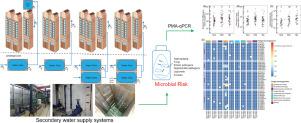Water Research ( IF 12.8 ) Pub Date : 2021-09-23 , DOI: 10.1016/j.watres.2021.117690 Dong Hu 1 , Huarong Hong 2 , Biao Rong 2 , Yating Wei 3 , Jie Zeng 4 , Jun Zhu 5 , Lijun Bai 3 , Feng Guo 5 , Xin Yu 3

|
Secondary water supply systems (SWSSs) are characterized by long water stagnation and low levels of chlorine residuals, which may pose a high microbial risk to terminal users. In this study, the SWSSs of 12 residential neighborhoods in a metropolitan area of 5 million people in southeastern China were seasonally investigated to assess their microbial risks by determining more than 30 physicochemical and biological parameters. Although the microbiological quality of SWSS water met the requirements of the standards for drinking water quality of China, it did deteriorate in various aspects. The heterotrophic plate counts with R2A media were high (> 100 CFU/mL) in some SWSS tank and tap water samples. Propidium monoazide (PMA)-qPCR revealed a one magnitude higher abundance of viable bacteria in the tank and tap water samples (average 103.63±1.10 and 103.65±1.25 gene copies/mL, respectively) compared with the input water samples, and Enterococcus, Acanthamoeba, and Hartmannella vermiformis were only detected in the tanks. In particular, the high detection frequency of Legionella in 35% tank and 21% tap water samples suggested it is a supplementary microbial safety indicator in SWSSs. The microbial regrowth potential was more obvious in summer, and Illumina sequencing also demonstrated distinct seasonal changes in the relative abundance of bacterial gene sequences at the genus level. Turbidity and residual chlorine were closely connected with total bacterial biomass, and the latter seemed responsible for microbial community structure alteration. The extremely low chlorine residuals associated with a high abundance of total bacteria (as high as 106.48 gene copies/mL) and Legionella (as high as 106.71 gene copies/100 mL) in the closed valve tanks highlighted the high microbial risk increased by mishandling the operation of SWSSs. This study found that SWSSs possessed a higher microbial risk than the drinking water network, which suggested that the frequency and scope of monitoring the microbial risk of SWSSs in megacities should be strengthened for the purpose of waterborne epidemic disease prevention and control.



























 京公网安备 11010802027423号
京公网安备 11010802027423号